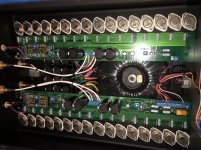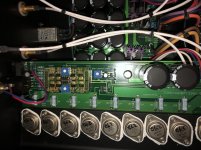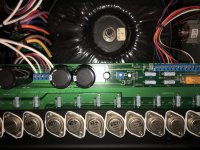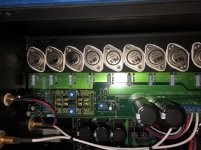Hi all,
This is my first post here so bare with me as I’m a somewhat newbie when playing with electronics. So I noticed my Pass Labs X250 seemed to be running on the cool side and not really getting warm to the touch. So after reading a ton on the subject I decided to adjust the bias a little using this forum and a couple other places as a guide.
I adjusted the bias pots to make both heat sinks hold at about 48 degrees which is stated in the manual for this amp. I then read to adjust the differential and absolute dc offset before putting everything back together t make sure everything is on the up and up. This is where I have run into a problem.
I successfully set both differential offsets to 0 plus or minus a few mv but when moving onto the absolute offset I only got the right channel to go down close to 0. The left channel with the pot turned all the way is only going down to about 1500mv or 1.5v. Does anyone have an idea where I may have messed up?
By the way I performed all adjustments after replacing the lid and letting things settle, trying to avoid temp swings.
Thanks for any help.
This is my first post here so bare with me as I’m a somewhat newbie when playing with electronics. So I noticed my Pass Labs X250 seemed to be running on the cool side and not really getting warm to the touch. So after reading a ton on the subject I decided to adjust the bias a little using this forum and a couple other places as a guide.
I adjusted the bias pots to make both heat sinks hold at about 48 degrees which is stated in the manual for this amp. I then read to adjust the differential and absolute dc offset before putting everything back together t make sure everything is on the up and up. This is where I have run into a problem.
I successfully set both differential offsets to 0 plus or minus a few mv but when moving onto the absolute offset I only got the right channel to go down close to 0. The left channel with the pot turned all the way is only going down to about 1500mv or 1.5v. Does anyone have an idea where I may have messed up?
By the way I performed all adjustments after replacing the lid and letting things settle, trying to avoid temp swings.
Thanks for any help.
if you did similar procedure as explained here : Pass Labs X150.5 , checking/adjusting offsets ,Iq and gain | Zen Mod Blog , then you did OK
1V5 is practically not cutting anything from allowable voltage window for output swing , so you're good
however , keep an eye on it in future , if it drifts up , time is for at least change of caps and maybe even something more
1V5 is practically not cutting anything from allowable voltage window for output swing , so you're good
however , keep an eye on it in future , if it drifts up , time is for at least change of caps and maybe even something more
Hi zen mod, I was hoping you would respond since that is the main article I used for a guide. I also used a thread where you explained to someone who had a X250 on how to perform the bias adjustment as well. I do have one question, in that thread you told the original poster to set the bias to about 60mv for all four source resistors in the “corners” of the amp basically. I ended up setting the left side of the amp to about 52mv because it was getting warmer than the right which I set to the 60. Did I do okay with this or should I have taken the left to 60mv anyway?
Hi zen mod, I was hoping you would respond since that is the main article I used for a guide. I also used a thread where you explained to someone who had a X250 on how to perform the bias adjustment as well. I do have one question, in that thread you told the original poster to set the bias to about 60mv for all four source resistors in the “corners” of the amp basically. I ended up setting the left side of the amp to about 52mv because it was getting warmer than the right which I set to the 60. Did I do okay with this or should I have taken the left to 60mv anyway?
60mV is ballpark value - also confirmation that electrically everything is OK
primary thing is heatsink temperature , and with voltage across source resistor you're confirming that all 4 quadrants are same and everything is OK
so - confirm uniformity of voltage readings , then you're sure that you have necessary symmetry
channels must be same temperature , when electrical readings are the same
if they're not of same temperature , and you don't know why , some puzzle is missing
pics - plenty of them ....... if nothing else , you know that we are addicted of porn
🙂
Alright guys, I turned the amp on this morning and after about 2.5 hours I took some readings and here is where it is at right now.
Left Channel: temp 49C rear resistor 52.1mv front resistor 55.2mv
Right Channel: temp 48.1C rear resistor 60.1mv front resistor 57.1mv
Should I still try to get all four closer to 60mv? By the way when you say make smaaalll adjustments you meant it.
Left Channel: temp 49C rear resistor 52.1mv front resistor 55.2mv
Right Channel: temp 48.1C rear resistor 60.1mv front resistor 57.1mv
Should I still try to get all four closer to 60mv? By the way when you say make smaaalll adjustments you meant it.
that's close enough
when you are there , check tightness of all Allen bolts at output transistors - they need to be all nicely and evenly tight
when you are there , check tightness of all Allen bolts at output transistors - they need to be all nicely and evenly tight
I actually tightened all of the output Allen bolts this morning before turning the amp on. So are you saying I should be good with all of those values and shouldn’t overthink this like I normally do everything else?
Awesome! Thank you for all of your help and at what point should I be worried about that absolute offset?
as I said , 1V is practically nothing ..... just take care that it stays here
if it starts creeping up in time , red button situation
edit: obviously didn't refreshed page for long time ..... Pa is always faster .......
if it starts creeping up in time , red button situation
edit: obviously didn't refreshed page for long time ..... Pa is always faster .......

so , as long it's sitting , you can sit and relax , too
in a meantime , you can put info of your location in your profile ........ often useful
in a meantime , you can put info of your location in your profile ........ often useful
Good idea...just updated location🙂
In the future as I keep an eye on the absolute offset, should I always disconnect speakers and short the inputs or is that something I can check on the fly with source components turned off but everything still connected? Sorry if that’s a dumb question just kind of learning as I go here.
In the future as I keep an eye on the absolute offset, should I always disconnect speakers and short the inputs or is that something I can check on the fly with source components turned off but everything still connected? Sorry if that’s a dumb question just kind of learning as I go here.
- Home
- Amplifiers
- Pass Labs
- Pass x250 absolute dc offset





